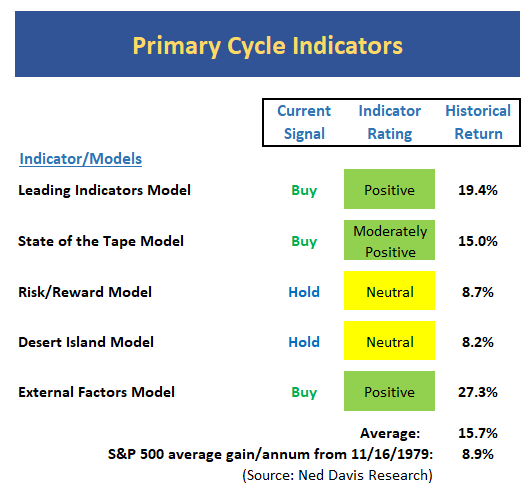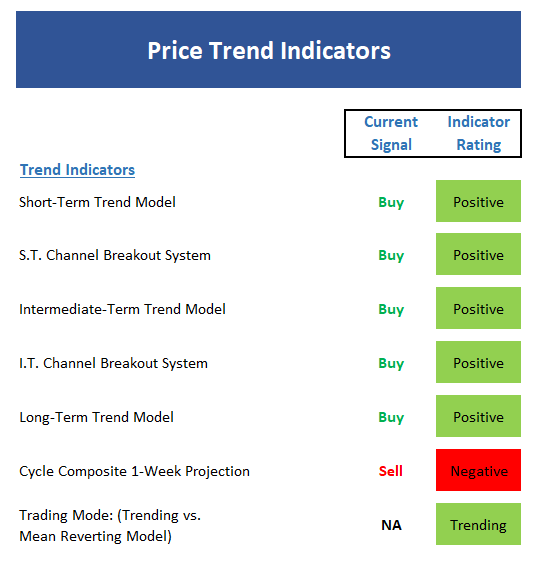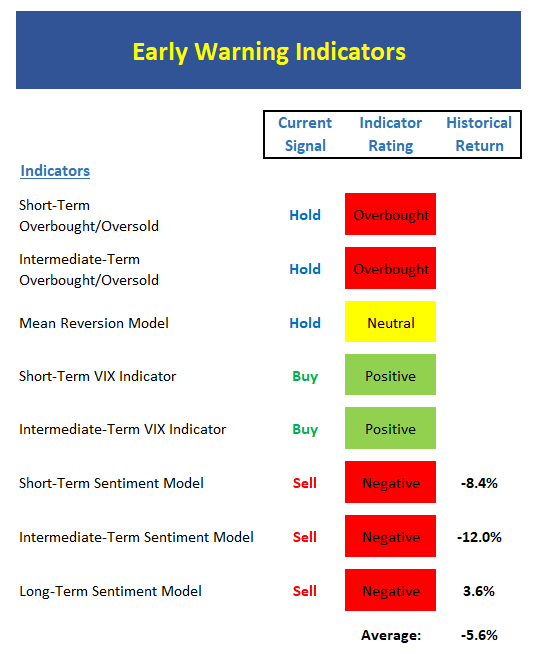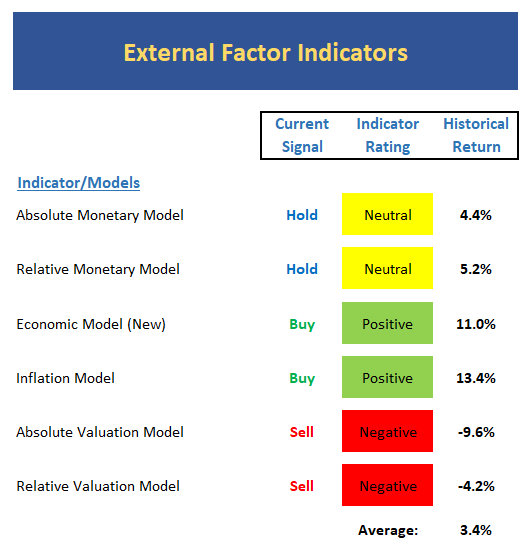No Time To Be A Hero
The "State of the Markets"
To review, my first report of each week is intended to take a big-picture, macro view of the overall market environment. The idea is to start the week with what we hope will be a solid understanding of what "is" happening in the market (as opposed to what you think "should" be taking place).
The primary reason I continue to do this exercise week after week, month after month, year after year is simple. If I can continuously identify what is actually going on in Ms. Market's game (and I can keep my ego checked at the door), then I shouldn't be surprised when the market environment changes. Remember, the business of investing isn't about "being right." No, it's about "getting it mostly right, most of the time."
The key here is that nobody should give a hoot about what I "think" is going to happen next. Heck, I shouldn't even care about trying to determine what stocks or bonds will do next. In my view, the game is about making sure my portfolios are positioned appropriately for the current environment.
So, the natural question as we enter the fourth trading week of the year is, how do we best define the current macro environment?
In attempting to answer this question, it is very easy to fall into the trap of making predictions. And this is the reason that I rely on the indicator boards displayed in this report each week. So, let's run through them and see what we come up with from an overall "message" standpoint.
Starting with the Primary Cycle board, which is designed to identify the dominant trend (i.e. bull vs. bear), my favorite big-picture models are in pretty good shape. And since there is no red on the board, I think we can call this a bull market. (Cue the "Captain Obvious" catcalls!)
Next up is the trend of the market. I look at this from several angles but the result is clear. The boxes are all green. And green is good, right?
Moving to the market internals (aka market momentum), I think a quick "ditto" will suffice here.
Now that we know what the trend is doing (moving from the lower left to the upper right) and if there is any "oomph" behind it (there is, check), I like to look at the "state of the trade" from a shorter-term perspective. Here I'm looking for signs that traders will begin to "go the other way" in the near-term. From my seat, I think this board suggests that the "table is set" for a pullback - assuming the bears can ever find a reason to be, of course! (And yes, feel free to insert an eye roll here.)
Then there is the External Factor board. This is where the analysis goes macro and can get very interesting. However, before we proceed here, it is vital to understand that the "message" from this board is oftentimes VERY early.
Currently, the External Factor board sports two yellow, two green, and two red boxes. As such, one could argue that the external factors are neutral. Yet I will point to the historical average return when the models are in their current modes as Exhibit A in the argument that risk is elevated here.
So, what is the overall macro message? For me, I see the following: a bull market that is aging, rising rates, overly optimistic sentiment, a strong economy, and extremely high valuations.
Thus, I will define the macro environment as a bull market with elevated risk levels.
The next question is, how does one play Ms. Market's game in this environment? The answer, of course, is up to each investor. As a risk manager responsible for other people's money, my approach is to continue to ride the bull train, but to do so with a reduced risk approach.
In other words, we want to stay in stocks as long as the bulls are in control of the game (keep an eye on the primary cycle board) because bull markets can last longer than anyone can imagine. Yet, given the "elevated risk" environment, I'm of the mind that this is no time to be a hero.
Thought For The Day:
Two monologues do not make a dialogue. -Jeff Daly
Wishing you green screens and all the best for a great day,

David D. Moenning
Chief Investment Officer Heritage Capital Research
Serving Financial Advisors since 1989
Serving individual investors since 1980
Quesitons, comments, or ideas? Contact Us
Disclosure: At the time of publication, Mr. Moenning held long positions in the following securities mentioned: None. Note that positions may change at any time.
The State of the Big-Picture Market Models
It's a new week, so let's start things off with a review of the state of the market - I.E. a review my favorite big-picture market models, which are designed to tell us which team is in control of the prevailing major trend.

View My Favorite Market Models Online
Executive Summary:
- The Leading Indicators model, which is long-term oriented, remains in great shape here.
- We have recently upgraded our "State of the tape" model to include an additional 5 indicator readings. The current reading of the new model is positive. BUT - the reading of the model has fallen hard over the last month as the current overbought condition has reached extreme levels, suggesting that risk of a correction is rising.
- The Risk/Reward model remains neutral. This is a big-picture warning that risk levels are elevated.
- If I had to manage money from a desert island and could only use one model, it would be this one - a combination of internal and external factors. Currently, the model remains on a long-term buy signal, however, the model reading is only neutral.
- The newly expanded External Factors model includes a total of 10 indicators ranging from earnings, yields, sentiment, monetary, economic, and volatility. The current model reading is positive.
- As you can plainly see, the models suggest stock market returns in excess of the historical average. So, the bottom line is the bulls remain in charge.
The State of the Trend
Digging into the details, I like to start my weekly review with a look at the "state of the trend." These indicators are designed to give us a feel for the overall health of the current short- and intermediate-term trend models.

View Trend Indicator Board Online
Executive Summary:
- Not sure I even need to mention this, but all of our Trend Models sport a bright shade of green here.
- Same song, different week… Both the short- and intermediate-term Channel Breakout Systems remain positive. A break below 2736 would turn the short-term indicator negative.
- The long-term Trend Model continues positive. Since 11/19/1929, the S&P 500 has gained at a rate of 9.1% per year in this mode vs. 5.7% per year for buy-and-hold and -3.4% per year when the model is on a sell signal.
- The Cycle Composite goes green this week, then red the next, and then back to green. Can you say "waffle mode"?
- The Trading Mode models continue to confirm the obvious - the market remains in a trending mode.
The State of Internal Momentum
Next up are the momentum indicators, which are designed to tell us whether there is any "oomph" behind the current trend.

View Momentum Indicator Board Online
Executive Summary:
- Both the short- and intermediate-term Trend and Breadth Confirm Models are positive.
- After spending one week in positive territory, the Industry Health Model slipped back into "moderately positive." There isn't much difference from a directional standpoint. However, the S&P has gained at an annualized rate of 29.1% when the model is positive and 12.7% when moderately positive.
- The short-term Volume Relationship remains positive, but our measure of up-volume isn’t exactly robust at this time.
- The intermediate-term Volume Relationship Model is in good shape. Although, as I've been saying, the level of "demand volume" remains below this cycle's high seen in late 2016.
- Not surprisingly, the Price Thrust Indicator continues to be positive at this time.
- The Volume Thrust Indicator - which is based on the NASDAQ - remains stubbornly neutral.
- The Breadth Thrust Indicator breaks the "thrust indicator" tie and thus, keeps the overall momentum indicators positive.
The State of the "Trade"
We also focus each week on the "early warning" board, which is designed to indicate when traders might start to "go the other way" -- for a trade.

View Early Warning Indicator Board Online
Executive Summary:
- From a near-term perspective, stocks remain overbought. However, as I've been saying, this is a "good overbought" condition and is a sign of market strength.
- From an intermediate-term view, stocks are also overbought. No, make that, VERY overbought, as our 40-day RSI reading on the NYSE has reached the highest level seen since 2000.
- The Mean Reversion Model continues to be out of sync and is wandering aimlessly in the neutral zone.
- While it may seem odd, the short-term VIX indicator flashed a buy signal on Friday as the VIX reversed the spike seen over the prior 2 weeks.
- And lest you think the volatility oddness is confined to the near-term, our longer-term VIX Indicator also flashed a fresh buy signal on Friday.
- From a short-term perspective, the market sentiment model remains negative.
- It should not be surprising to anyone that the intermediate-term Sentiment Model also remains entrenched in negative territory.
- Longer-term Sentiment readings are extremely negative as one of our favorite models reached the most negative reading ever (the model began in 1995)
The State of the Macro Picture
Now let's move on to the market's "external factors" - the indicators designed to tell us the state of the big-picture market drivers including monetary conditions, the economy, inflation, and valuations.

View External Factors Indicator Board Online
Executive Summary:
- Absolute Monetary conditions remain neutral. However, with rates breaking important levels, this is one of the key indicators to watch going forward.
- The Relative Monetary Model is technically in the neutral zone, but is falling hard within the zone.
- Our Economic Model continues to confirm the consensus that we are seeing a strong economic environment.
- The Inflation Model remains on a buy signal, but the reading of the model is starting to move the wrong direction.
- Up until last month, the Absolute Valuation Model had been improving a bit. However, the recent blast higher by the indices has caused this valuation indicator to move back toward cycle lows.
- Our Relative Valuation Model (a model that incorporates the current level of interest rates) flashed a sell signal last week. Thus, there can longer be any argument that valuation isn't a negative input.
- In sum, I think it is important to note that the historical return of our external board is significantly below normal.
Sample Risk Exposure System
Below is an EXAMPLE of how some of above indicators might be used in order to determine exposure to market risk. The approach used here is a "Model of Models" comprised of 10 independent Models. Each model included gives separate buy and sell signals, which affects a percentage of the model's overall exposure to the market.
Trend models control a total 40% of our exposure. The 3 Momentum Models and 3 Environment Models each control 10% of the portfolio's exposure to market risk. The model's "Exposure to Market Risk" reading (at the bottom of the Model) acts as an EXAMPLE of a longer-term guide to exposure to market risk.
In looking at the "bottom line" of this model, my take is that readings over 75% are "positive," readings between 50% and 75% are "moderately positive," and readings below 50% should be viewed as a warning that all is not right with the indicator world.

View Sample Exposure Model Online
The model above is for illustrative and informational purposes only and does not in any way represent any investment recommendation. The model is merely a sample of how indicators can be grouped to create a guide to market exposure based on the inputs from multiple indicators/models.
Current Market Drivers
We strive to identify the driving forces behind the market action on a daily basis. The thinking is that if we can both identify and understand why stocks are doing what they are doing on a short-term basis; we are not likely to be surprised/blind-sided by a big move. Listed below are what we believe to be the driving forces of the current market (Listed in order of importance).
1. The State of the Economy
2. The State of Fed Policy
3. The State of Earnings Growth
Indicators Explained
Short-Term Trend-and-Breadth Signal Explained: History shows the most reliable market moves tend to occur when the breadth indices are in gear with the major market averages. When the breadth measures diverge, investors should take note that a trend reversal may be at hand. This indicator incorporates NDR's All-Cap Dollar Weighted Equity Series and A/D Line. From 1998, when the A/D line is above its 5-day smoothing and the All-Cap Equal Weighted Equity Series is above its 25-day smoothing, the equity index has gained at a rate of +32.5% per year. When one of the indicators is above its smoothing, the equity index has gained at a rate of +13.3% per year. And when both are below, the equity index has lost +23.6% per year.
Channel Breakout System Explained: The short-term and intermediate-term Channel Breakout Systems are modified versions of the Donchian Channel indicator. According to Wikipedia, "The Donchian channel is an indicator used in market trading developed by Richard Donchian. It is formed by taking the highest high and the lowest low of the last n periods. The area between the high and the low is the channel for the period chosen."
Intermediate-Term Trend-and-Breadth Signal Explained: This indicator incorporates NDR's All-Cap Dollar Weighted Equity Series and A/D Line. From 1998, when the A/D line is above its 45-day smoothing and the All-Cap Equal Weighted Equity Series is above its 45-day smoothing, the equity index has gained at a rate of +17.6% per year. When one of the indicators is above its smoothing, the equity index has gained at a rate of +6.5% per year. And when both are below, the equity index has lost -1.3% per year.
Industry Health Model Explained: Designed to provide a reading on the technical health of the overall market, Big Mo Tape takes the technical temperature of more than 100 industry sectors each week. Looking back to early 1980, when the model is rated as "positive," the S&P has averaged returns in excess of 23% per year. When the model carries a "neutral" reading, the S&P has returned over 11% per year. But when the model is rated "negative," stocks fall by more than -13% a year on average.
Cycle Composite Projections: The cycle composite combines the 1-year Seasonal, 4-year Presidential, and 10-year Decennial cycles. The indicator reading shown uses the cycle projection for the upcoming week.
Trading Mode Indicator: This indicator attempts to identify whether the current trading environment is "trending" or "mean reverting." The indicator takes the composite reading of the Efficiency Ratio, the Average Correlation Coefficient, and Trend Strength models.
Volume Relationship Models: These models review the relationship between "supply" and "demand" volume over the short- and intermediate-term time frames.
Price Thrust Model Explained: This indicator measures the 3-day rate of change of the Value Line Composite relative to the standard deviation of the 30-day average. When the Value Line's 3-day rate of change have moved above 0.5 standard deviation of the 30-day average ROC, a "thrust" occurs and since 2000, the Value Line Composite has gained ground at a rate of +20.6% per year. When the indicator is below 0.5 standard deviation of the 30-day, the Value Line has lost ground at a rate of -10.0% per year. And when neutral, the Value Line has gained at a rate of +5.9% per year.
Volume Thrust Model Explained: This indicator uses NASDAQ volume data to indicate bullish and bearish conditions for the NASDAQ Composite Index. The indicator plots the ratio of the 10-day total of NASDAQ daily advancing volume (i.e., the total volume traded in stocks which rose in price each day) to the 10-day total of daily declining volume (volume traded in stocks which fell each day). This ratio indicates when advancing stocks are attracting the majority of the volume (readings above 1.0) and when declining stocks are seeing the heaviest trading (readings below 1.0). This indicator thus supports the case that a rising market supported by heavier volume in the advancing issues tends to be the most bullish condition, while a declining market with downside volume dominating confirms bearish conditions. When in a positive mode, the NASDAQ Composite has gained at a rate of +38.3% per year, When neutral, the NASDAQ has gained at a rate of +13.3% per year. And when negative, the NASDAQ has lost at a rate of -8.5% per year.
Breadth Thrust Model Explained: This indicator uses the number of NASDAQ-listed stocks advancing and declining to indicate bullish or bearish breadth conditions for the NASDAQ Composite. The indicator plots the ratio of the 10-day total of the number of stocks rising on the NASDAQ each day to the 10-day total of the number of stocks declining each day. Using 10-day totals smooths the random daily fluctuations and gives indications on an intermediate-term basis. As expected, the NASDAQ Composite performs much better when the 10-day A/D ratio is high (strong breadth) and worse when the indicator is in its lower mode (weak breadth). The most bullish conditions for the NASDAQ when the 10-day A/D indicator is not only high, but has recently posted an extreme high reading and thus indicated a thrust of upside momentum. Bearish conditions are confirmed when the indicator is low and has recently signaled a downside breadth thrust. In positive mode, the NASDAQ has gained at a rate of +22.1% per year since 1981. In a neutral mode, the NASDAQ has gained at a rate of +14.5% per year. And when in a negative mode, the NASDAQ has lost at a rate of -6.4% per year.
Short-Term Overbought/sold Indicator: This indicator is the current reading of the 14,1,3 stochastic oscillator. When the oscillator is above 80 and the %K is above the %D, the indicator gives an overbought reading. Conversely, when the oscillator is below 20 and %K is below its %D, the indicator is oversold.
Intermediate-Term Overbought/sold Indicator: This indicator is a 40-day RSI reading. When above 57.5, the indicator is considered overbought and when below 45 it is oversold.
Mean Reversion Model: This is a diffusion model consisting of five indicators that can produce buy and sell signals based on overbought/sold conditions.
VIX Indicator: This indicator looks at the current reading of the VIX relative to standard deviation bands. When the indicator reaches an extreme reading in either direction, it is an indication that a market trend could reverse in the near-term.
Short-Term Sentiment Indicator: This is a model-of-models composed of 18 independent sentiment indicators designed to indicate when market sentiment has reached an extreme from a short-term perspective. Historical analysis indicates that the stock market's best gains come after an environment has become extremely negative from a sentiment standpoint. Conversely, when sentiment becomes extremely positive, market returns have been subpar.
Intermediate-Term Sentiment Indicator: This is a model-of-models composed of 7 independent sentiment indicators designed to indicate when market sentiment has reached an extreme from an intermediate-term perspective. Historical analysis indicates that the stock market's best gains come after an environment has become extremely negative from a sentiment standpoint. Conversely, when sentiment becomes extremely positive, market returns have been subpar.
Long-Term Sentiment Indicator: This is a model-of-models composed of 6 independent sentiment indicators designed to indicate when market sentiment has reached an extreme from a long-term perspective. Historical analysis indicates that the stock market's best gains come after an environment has become extremely negative from a sentiment standpoint. Conversely, when sentiment becomes extremely positive, market returns have been subpar.
Absolute Monetary Model Explained: The popular cliché, "Don't fight the Fed" is really a testament to the profound impact that interest rates and Fed policy have on the market. It is a proven fact that monetary conditions are one of the most powerful influences on the direction of stock prices. The Absolute Monetary Model looks at the current level of interest rates relative to historical levels and Fed policy.
Relative Monetary Model Explained: The "relative" monetary model looks at monetary indicators relative to recent levels as well as rates of change and Fed Policy.
Economic Model Explained: During the middle of bull and bear markets, understanding the overall health of the economy and how it impacts the stock market is one of the few truly logical aspects of the stock market. When our Economic model sports a "positive" reading, history (beginning in 1965) shows that stocks enjoy returns in excess of 21% per year. Yet, when the model's reading falls into the "negative" zone, the S&P has lost nearly -25% per year. However, it is vital to understand that there are times when good economic news is actually bad for stocks and vice versa. Thus, the Economic model can help investors stay in tune with where we are in the overall economic cycle.
Inflation Model Explained: They say that "the tape tells all." However, one of the best "big picture" indicators of what the market is expected to do next is inflation. Simply put, since 1962, when the model indicates that inflationary pressures are strong, stocks have lost ground. Yet, when inflationary pressures are low, the S&P 500 has gained ground at a rate in excess of 13%. The bottom line is inflation is one of the primary drivers of stock market returns.
Valuation Model Explained: If you want to get analysts really riled up, you need only to begin a discussion of market valuation. While the question of whether stocks are overvalued or undervalued appears to be a simple one, the subject is extremely complex. To simplify the subject dramatically, investors must first determine if they should focus on relative valuation (which include the current level of interest rates) or absolute valuation measures (the more traditional readings of Price/Earnings, Price/Dividend, and Price/Book Value). We believe that it is important to recognize that environments change. And as such, the market's focus and corresponding view of valuations are likely to change as well. Thus, we depend on our Valuation Models to help us keep our eye on the ball.
Disclosures
The opinions and forecasts expressed herein are those of Mr. David Moenning and may not actually come to pass. Mr. Moenning's opinions and viewpoints regarding the future of the markets should not be construed as recommendations. The analysis and information in this report is for informational purposes only. No part of the material presented in this report is intended as an investment recommendation or investment advice. Neither the information nor any opinion expressed constitutes a solicitation to purchase or sell securities or any investment program.
Any investment decisions must in all cases be made by the reader or by his or her investment adviser. Do NOT ever purchase any security without doing sufficient research. There is no guarantee that the investment objectives outlined will actually come to pass. All opinions expressed herein are subject to change without notice. Neither the editor, employees, nor any of their affiliates shall have any liability for any loss sustained by anyone who has relied on the information provided.
Mr. Moenning may at times have positions in the securities referred to and may make purchases or sales of these securities while publications are in circulation. Positions may change at any time.
The analysis provided is based on both technical and fundamental research and is provided "as is" without warranty of any kind, either expressed or implied. Although the information contained is derived from sources which are believed to be reliable, they cannot be guaranteed.
Investments in equities carry an inherent element of risk including the potential for significant loss of principal. Past performance is not an indication of future results.
